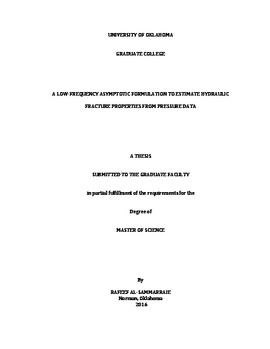| dc.contributor.advisor | Devegowda, Deepak | |
| dc.contributor.author | Al-Sammarraie, Rafeef | |
| dc.date.accessioned | 2016-12-19T21:15:21Z | |
| dc.date.available | 2016-12-19T21:15:21Z | |
| dc.date.issued | 2016-12-16 | |
| dc.identifier.uri | https://hdl.handle.net/11244/47098 | |
| dc.description.abstract | The key drivers of success in unconventional oil and gas recovery, specifically in shale plays, is the rapid growth in hydraulic fracturing and horizontal well technology. With these completion methods, wells contact increasingly larger reservoir volumes with highly conductive pathways for fluid flow from ultra-low permeability formations.
Although the industry is moving towards larger fracture stage designs and increasing number of fracture stages per well, there is very limited post-fracture analysis of the subsequent well performance. Decline curve analysis and rate/pressure transient analysis are the most common approaches to interpret production data, often in real-time, to assess formation and hydraulic fracture properties such as matrix permeabilities and effective fracture half lengths. While these methods are powerful and have been successfully applied to several thousands of wells across several shale plays, the biggest drawback of these approaches is that they have limited utility when addressing multiphase flow and when dealing with complex fracture patterns. This is because the underlying equations rely on analytic formulations that are restricted to certain classes of well and completion geometries.
In this thesis, I utilize a numerical simulation based approach that addresses the challenges of analytic formulations and simultaneously allows for rapid characterization of the reservoir and the hydraulic fracture geometries. The method is based on utilizing the frequency content of pressure data to estimate large-scale reservoir- and completion-related variables. The advantage of this approach is that is permits generalization to any level of fracture and well complexity. The numerical simulation model can additionally be constrained to known heterogeneities and structural features and therefore preserves geologic realism for more accurate forecasting and predictions. The approach has previously been applied to cross-well pumping tests for interpretation of inter-well connectivity. In this thesis, I demonstrate the power and utility of this approach on synthetic case studies as well as a field-case study to estimate hydraulic fracture permeabilities/conductivities. | en_US |
| dc.language | en | en_US |
| dc.subject | Asymptotic Frequency Fracture Permeability | en_US |
| dc.title | A LOW-FREQUENCY ASYMPTOTIC FORMULATION TO ESTIMATE HYDRAULIC FRACTURE PROPERTIES FROM PRESSURE DATA | en_US |
| dc.contributor.committeeMember | Misra, Siddharth | |
| dc.contributor.committeeMember | Moghanloo, Rouzbeh | |
| dc.date.manuscript | 2016-12-16 | |
| dc.thesis.degree | Master of Science | en_US |
| ou.group | Mewbourne College of Earth and Energy::Mewbourne School of Petroleum and Geological Engineering | en_US |
